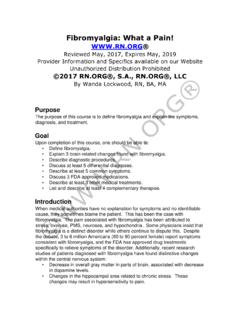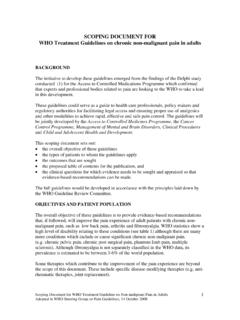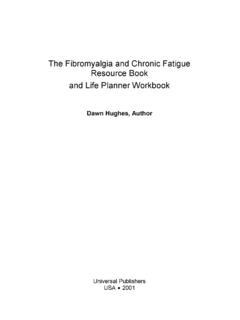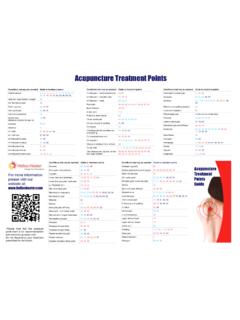Transcription of Low back pain - WHO
1 671 Bulletin of the world health organization 2003, 81 (9)IntroductionLow back pain is neither a disease nor a diagnostic entity ofany sort. The term refers to pain of variable duration in anarea of the anatomy afflicted so often that it is has become aparadigm of responses to external and internal stimuli forexample, Oh, my aching back is an expression used tomean that a person is troubled. The incidence and preva-lence of low back pain are roughly the same the world over wherever epidemiological data have been gathered or esti-mates made but such pain ranks high (often first) as acause of disability and inability to work, as an interferencewith the quality of life, and as a reason for medical consul-tation.
2 In many instances, however, the cause is obscure, andonly in a minority of cases does a direct link to some definedorganic disease exist. This article does not deal with specific and attributablelow back pain that results from trauma, osteoporotic frac-tures, infections, neoplasms, and other mechanical derange-ments such causes can be identified and must be dealtwith appropriately. In the vast majority of instances thecause of low back pain is obscure or nebulous, and thesecases are the focus of concern for WHO (1), whoseCommunity Oriented Programme for the Control ofRheumatic Disease showed convincingly that it is present insimilar proportions in several countries.
3 This is true even ifthe low back pain is unrecognized usually because ofsocial reasons; for example, where manual labour is thenorm, the absence of one labourer because of back pain isbarely noticed if another is available to do the work; inindustrialized settings, however, where time and money havebeen spent on training an employee, absence is more likelyto be noticed and substitution often is not from sick funds and social security and com-pensation systems often results. Two multidisciplinary publications have looked at thesubject of low back pain : Low back problems in adults (2) andthe report on WHO s own survey results Low back pain ini-tiative (1).
4 Both confirm that most people can continue towork despite their back problem but that recognition of theprevalence of these symptoms should be taken to allow effec-tive prevention and treatment to be offered. Although acute(and under some classifications, subacute) episodes that lastup to three months are the commonest presentation of lowback pain and recurrent bouts of such episodes are thenorm chronic back pain ultimately is more disabling anddispiriting because of the physical impediment it causes andits psychological effects. Chronic back pain also has beencaught up in medical controversies, especially aboutfibromyalgia and kindred syndromes or disorders and aboutwhat work-up and treatments are appropriate.
5 Many doctorsorder elaborate studies when non-specific back pain is pre-sented, including X-rays and magnetic resonance imaging,with little guidance to treatment decisions being the result. For arbitrary classification purposes, chronic pain gen-erally is defined as pain that has persisted beyond normal tis-sue healing time (or about three months) (3) it is notmerely acute pain that has lasted longer than would beLow back painGeorge E. Ehrlich1 AbstractLow back pain is a leading cause of disability. It occurs in similar proportions in all cultures, interferes with quality of lifeand work performance, and is the most common reason for medical consultations.
6 Few cases of back pain are due to specificcauses; most cases are non-specific. Acute back pain is the most common presentation and is usually self-limiting, lasting less thanthree months regardless of treatment. Chronic back pain is a more difficult problem, which often has strong psychological overlay:work dissatisfaction, boredom, and a generous compensation system contribute to it. Among the diagnoses offered for chronicpain is fibromyalgia, an urban condition (the diagnosis is not made in rural settings) that does not differ materially from otherinstances of widespread chronic pain .
7 Although disc protrusions detected on X-ray are often blamed, they rarely are responsiblefor the pain , and surgery is seldom successful at alleviating it. No single treatment is superior to others; patients prefermanipulative therapy, but studies have not demonstrated that it has any superiority over others. A WHO Advisory Panel has definedcommon outcome measures to be used to judge the efficacy of treatments for back pain /classification/etiology/therapy; Fibromyalgia; Risk factors; Treatment outcome (source: MeSH, NLM).Mots cl sLombalgie/classification/ tiologie/th rapeutique; C llulalgie; Facteur risque; Evaluation r sultats traitement (source:MeSH, INSERM).
8 Palabras claveDolor de la regi n lumbar/clasificaci n/etiolog a/terapia; Fibromialgia; Factores de riesgo; Resultado deltratamiento (fuente: DeCS, BIREME).Bulletin of the world health organization 2003;81 page 675 le r sum en fran ais. En la p gina 675 figura un resumen en espa South Sixth Street, Suite 1101, Philadelphia, PA 19106-3731, USA (email: once the child is delivered. Some activities such asjogging and running on cement roads rather than cindertracks, heavy lifting, and prolonged sitting (especially in cars,trucks, and poorly designed chairs) can provoke back , strong psychological factors do play a back painPsychological factors are even more important in peoplewith chronic back pain .)
9 Dissatisfaction with a work situa-tion, a supervisor, or a dead-end job and boredom con-tribute greatly to the onset and persistence of back pain (8).As already mentioned, liberal compensation systems play arole in prolonging such pain not because of malingering,but rather because compensation leads to the now commonperception that back pain is an injury. Curiously, it is classi-fied thus in the industrial setting, in which workers com-pensation systems or sick-funds come into play (8).Under the former WHO classification, back painwould be considered as a disability, and the social, design,and architectural barriers would be its handicaps (9).
10 Otheractivities often blamed weight, lumbar lordosis, height,body mass index, and discrepancy between leg lengths may not play a major role (2). As stated, job dissatisfactionseems to be an important factor, but that, too, may reflectthe pattern of reporting rather than actual causation (8).Disc herniation and spinal canal narrowing are so commonas to be shown by imaging in most of the population in theirlater years, and in most cases, such conditions are notresponsible for the pain . They often are cited as reasons forsurgery, but only rarely are operations successful in alleviat-ing the pain definitively (10).
















